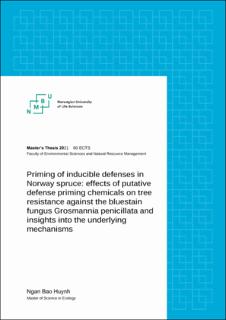| dc.description.abstract | Priming of inducible defenses in Norway spruce could be a cost-effective strategy to protect trees from herbivores and pathogens. In this study, my aim was to identify chemical priming agents that can increase the resistance of Norway spruce plants to pathogenic fungi and investigate the mechanisms underlying defense priming. To test different priming agents, I treated 1-year-old spruce plants with methyl jasmonate (MeJA), β-amino butyric acid (BABA), hexanoic acid or thiamine, and assessed plant resistance by inoculating plants with the bark beetle-associated bluestain fungus Grosmannia penicillata 4 weeks later. To study defense priming mechanism, I quantified the expression level of selected defense-related genes (ACS, PAL1, LOX, TPS-Car, Chi4 and NRPE1) at specific time points post-treatment and post-challenge (fungal inoculation). I also investigated phenolic and terpene responses at the same time points by quantifying traumatic resin duct (TRD) formation in the sapwood and concentrations of phenolics and terpenes in the phloem. Because the plants developed negligible symptoms to inoculation with G. penicillata I could not compare the resistance of plants treated with different priming chemicals and thus could not identify novel spruce priming agents. Considering the mechanical wounding inflicted by fungal inoculation as a defense triggering stimulus, I observed several types of defense responses, categorized by the response patterns, with respect to gene expression, TRD formation and chemical analyses. Most assessed genes were differentially expressed in MeJA-treated plants only during the post-treatment period or showed a prolonged induced defense response to MeJA treatment. Although TRD formation showed a primed response to MeJA treatment and wounding, terpenes did not. For the first time, flavan-3-ols were shown to have a primed response to MeJA treatment. Furthermore, I found evidence that MeJA treatment represses DNA methylation from the downregulation of NRPE1 expression. Overall, my results confirm that MeJA is a potential priming stimulus for Norway spruce. Contrastingly, I could not draw any solid conclusions about BABA in this study. Further studies with successful fungal inoculation are needed to identify new chemical priming agents in Norway spruce. To better understand the mechanisms of priming of inducible defenses in Norway spruce, future studies should also investigate how ontogeny influences Norway spruce defenses. | en_US |

